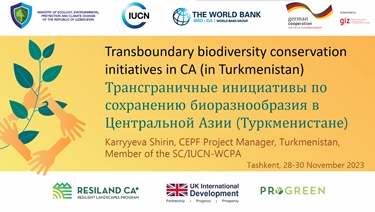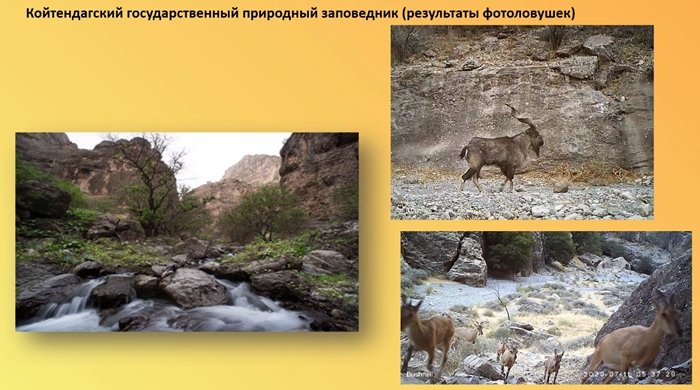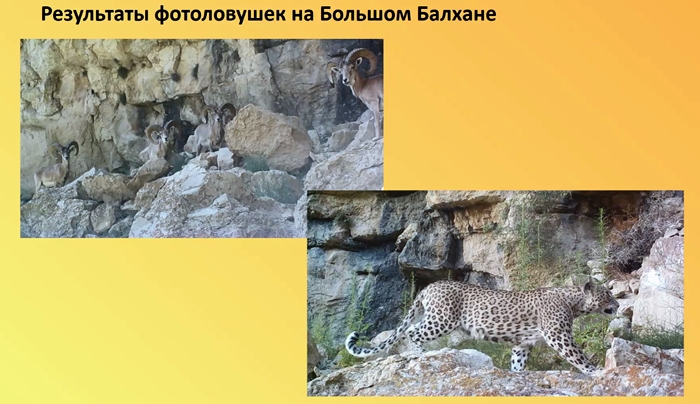As we reported, a Regional Dialogue on Transboundary Conservation of biodiversity in Central Asia is taking place in Tashkent these days, which brought together by representatives of environmental ministries and departments of Kazakhstan, the Kyrgyz Republic, Tajikistan, Turkmenistan and Uzbekistan, as well as numerous national and international organizations.
One of the speakers and moderators of the forum was an expert from Turkmenistan Shirin Karryyeva, a member of the IUCN World Commission on Protected Areas, project coordinator for Central Asia of the Critical Ecosystem Partnership Fund (CEPF) (Cooperation Fund for the Conservation of Ecosystems in Critical Condition). In her report, she presented cross-border environmental initiatives implemented in Turkmenistan.
Here are the key points from Shirin Karryyeva’s presentation:
Cold winter deserts of Turan
One of the examples of cross-border regional cooperation in Central Asia was the inclusion in the UNESCO World Heritage List on 20 September 2023 of the serial nomination “Cold Winter Deserts of Turan” by Kazakhstan, Uzbekistan and Turkmenistan. This is the first nature World Heritage nomination in Turkmenistan. The object includes such Turkmen protected natural territories as the Repetek Biosphere Reserve, Kaplankyr Reserve, Bereketli-Karakum Reserve.
As the expert noted, the environmental ministries of Kazakhstan, Turkmenistan and Uzbekistan signed a Memorandum of Understanding on the protection of the Turan deserts.
Nature Reserves of Turkmenistan with Cross-Border Territories
Seven of Turkmenistan’s nine nature reserves share their boundaries with neighboring countries.
In the west, the Kaplankyr Reserve borders Kazakhstan and Uzbekistan, while the Koytendag Reserve in the east adjoins the Surkhan Reserve of Uzbekistan and the Amudarya Reserve. Additionally, the Syunt-Khasardag, Kopetdag, and Badkhyz Nature Reserves lie along the Iranian-Afghan border. This transboundary network of protected areas safeguards unique biodiversity and promotes conservation efforts across national borders.
Uzbekistan and Turkmenistan will prepare a nomination dossier for the inclusion of the Koytendag mountain ecosystem in the UNESCO Natural World Heritage List
Intensive work is underway to study the biodiversity of the Koytendag mountain ecosystem, in accordance with the recommendations of the IUCN. The Center for Large Landscapes Conservation of (CLLC, USA) launched the CERF-I Project “Connectivity, Capacity and Cats: Building Resiliency in the Mountain Ecosystems of Koytendag” (2021-2023), which is funded by the Cooperation Fund for the Conservation of Ecosystems in Critical Condition.
The main focus of the project was the development of scientific potential, the provision of monitoring equipment, and the use of SMART monitoring. In addition, within the framework of the project, camera traps have been installed on the territory of the reserve, recording the movement of ungulates – for example, marhurs and argali.
shoots from camera traps – Koytendag National Reserve
A joint project with the CERF-II Center for Large Landscapes Conservation “Connectivity, Capacity and Cats: Building Resiliency in the Mountain Ecosystems of Koytendag” will be continued in 2023-2025. For this purpose, a second grant has been allocated to continue the work started.
Within the framework of this project, SMART-monitoring of biodiversity, measures for the protection of biodiversity, and field expeditions to collect scientific information and data are also being carried out.
It is also planned to develop a transnational serial nomination dossier on the Koytendag ecosystem together with Uzbekistan for designating as a UNESCO Natural World Heritage Site.
Turkmenistan is working on the creation of a new reserve
A regional project titled “Main Corridors for Central Asian Cats” was launched for 2023-2026 by the Conservation X Lab, National Geographic, and Segre Foundation, according to Sh.Karryeva. The project aims to promote the creation of a new Balkhan State Nature Reserve, which would become Turkmenistan’s 10th nature reserve.
SMART monitoring has begun within the project framework, and field expeditions are being conducted to gather scientific information and data in preparation for the justification for creating a new Big Balkhan Nature Reserve.
Shoots from camera traps – Big Balkhan
“The creation of a nature reserve in the Big Balkhan is included in the National Forest Program of Turkmenistan. By 2025, the reserve should be created, this work is actively underway now,” the expert said.
In addition, the “Main Corridors for Central Asian Cats” project aims to establish a protected corridor between the Big Balkhan Ridge and the Ustyurt Nature Reserve in Kazakhstan, restore ecological connectivity on the Ustyurt plateau between Turkmenistan and Kazakhstan for the migration of ungulates and predators, and give Ustyurt the status of a transboundary UNESCO World Heritage Site.
The project covers three countries – Turkmenistan, Kazakhstan and Kyrgyzstan. ///nCa, 28 November 2023


